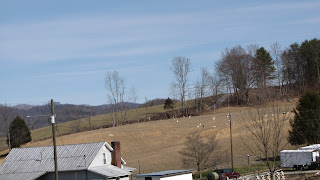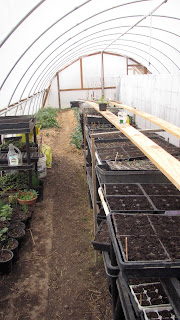 |
Nothing says picturesque
like sheep on a hill |
 |
| Springtime means babies! |

And so beings a new farming season! Last year we visited 17 farms, met some amazing people, learned a variety of farming skills and techniques, and began forming ideas of what our future farm might look like. This year will be a change of pace as we will be working on one farm for the entire season. This will allow us to finally see the seeds we plant from start to finish, and set down some (temporary) roots of our own. We are returning to
Spring Creek Farm in Pioneer, TN to join Adam and Shelby as they begin another year of supplying excellent produce, eggs and meats to their CSA, local restaurants, and the Knoxville farmers market (see our previous posts about them
here and
here). The choice to return was an easy one, not only because the scale and diversification of their farm are similar to what we hope to have in the future, but Adam and Shelby are incredibly knowledgeable people who have been in the business for years, and are a lot of fun to be around.
* * *
 |
| Look at all that potential! |
 |
| It may be snowy outside, but there's still plenty to do. |

Arriving later than we expected, we went straight to our woodshed-turned-cabin to unpack and get our bearings. It warmed our hearts (and our hands) to see that a light and a heater had been left on for us, and that the woodshed had shed all remnants of its previous existence, providing us with a cozy cabin to ourselves. The next day we enjoyed our last morning of not rising early to feed the multitude of farm animals. After reacquainting ourselves with one of Adam's delicious breakfasts, we took a leisurely walk around Spring Creek Farm while Adam showed us the current projects and discussed his and Shelby's ideas for the season. We also met Celia, Rosie, and Matt, the three WWOOFers who had already started the season here. Last year Adam and Shelby hosted over 40 WWOOFers and this year is shaping up to be similar. Even though they left shortly after we arrived, we had fun getting to know Celia and Rosie, two friends from California who had recently been to
Broken Magnolia, the goat farm we worked on in Mississippi. Matt had been here over a month by the time we arrived, and was enjoying the farm life.
With several spring-like days over the last few weeks, it's easy for us to be excited to be working the land and starting a whole new season.


 And so beings a new farming season! Last year we visited 17 farms, met some amazing people, learned a variety of farming skills and techniques, and began forming ideas of what our future farm might look like. This year will be a change of pace as we will be working on one farm for the entire season. This will allow us to finally see the seeds we plant from start to finish, and set down some (temporary) roots of our own. We are returning to Spring Creek Farm in Pioneer, TN to join Adam and Shelby as they begin another year of supplying excellent produce, eggs and meats to their CSA, local restaurants, and the Knoxville farmers market (see our previous posts about them here and here). The choice to return was an easy one, not only because the scale and diversification of their farm are similar to what we hope to have in the future, but Adam and Shelby are incredibly knowledgeable people who have been in the business for years, and are a lot of fun to be around.
And so beings a new farming season! Last year we visited 17 farms, met some amazing people, learned a variety of farming skills and techniques, and began forming ideas of what our future farm might look like. This year will be a change of pace as we will be working on one farm for the entire season. This will allow us to finally see the seeds we plant from start to finish, and set down some (temporary) roots of our own. We are returning to Spring Creek Farm in Pioneer, TN to join Adam and Shelby as they begin another year of supplying excellent produce, eggs and meats to their CSA, local restaurants, and the Knoxville farmers market (see our previous posts about them here and here). The choice to return was an easy one, not only because the scale and diversification of their farm are similar to what we hope to have in the future, but Adam and Shelby are incredibly knowledgeable people who have been in the business for years, and are a lot of fun to be around.

 Arriving later than we expected, we went straight to our woodshed-turned-cabin to unpack and get our bearings. It warmed our hearts (and our hands) to see that a light and a heater had been left on for us, and that the woodshed had shed all remnants of its previous existence, providing us with a cozy cabin to ourselves. The next day we enjoyed our last morning of not rising early to feed the multitude of farm animals. After reacquainting ourselves with one of Adam's delicious breakfasts, we took a leisurely walk around Spring Creek Farm while Adam showed us the current projects and discussed his and Shelby's ideas for the season. We also met Celia, Rosie, and Matt, the three WWOOFers who had already started the season here. Last year Adam and Shelby hosted over 40 WWOOFers and this year is shaping up to be similar. Even though they left shortly after we arrived, we had fun getting to know Celia and Rosie, two friends from California who had recently been to Broken Magnolia, the goat farm we worked on in Mississippi. Matt had been here over a month by the time we arrived, and was enjoying the farm life.
Arriving later than we expected, we went straight to our woodshed-turned-cabin to unpack and get our bearings. It warmed our hearts (and our hands) to see that a light and a heater had been left on for us, and that the woodshed had shed all remnants of its previous existence, providing us with a cozy cabin to ourselves. The next day we enjoyed our last morning of not rising early to feed the multitude of farm animals. After reacquainting ourselves with one of Adam's delicious breakfasts, we took a leisurely walk around Spring Creek Farm while Adam showed us the current projects and discussed his and Shelby's ideas for the season. We also met Celia, Rosie, and Matt, the three WWOOFers who had already started the season here. Last year Adam and Shelby hosted over 40 WWOOFers and this year is shaping up to be similar. Even though they left shortly after we arrived, we had fun getting to know Celia and Rosie, two friends from California who had recently been to Broken Magnolia, the goat farm we worked on in Mississippi. Matt had been here over a month by the time we arrived, and was enjoying the farm life.














